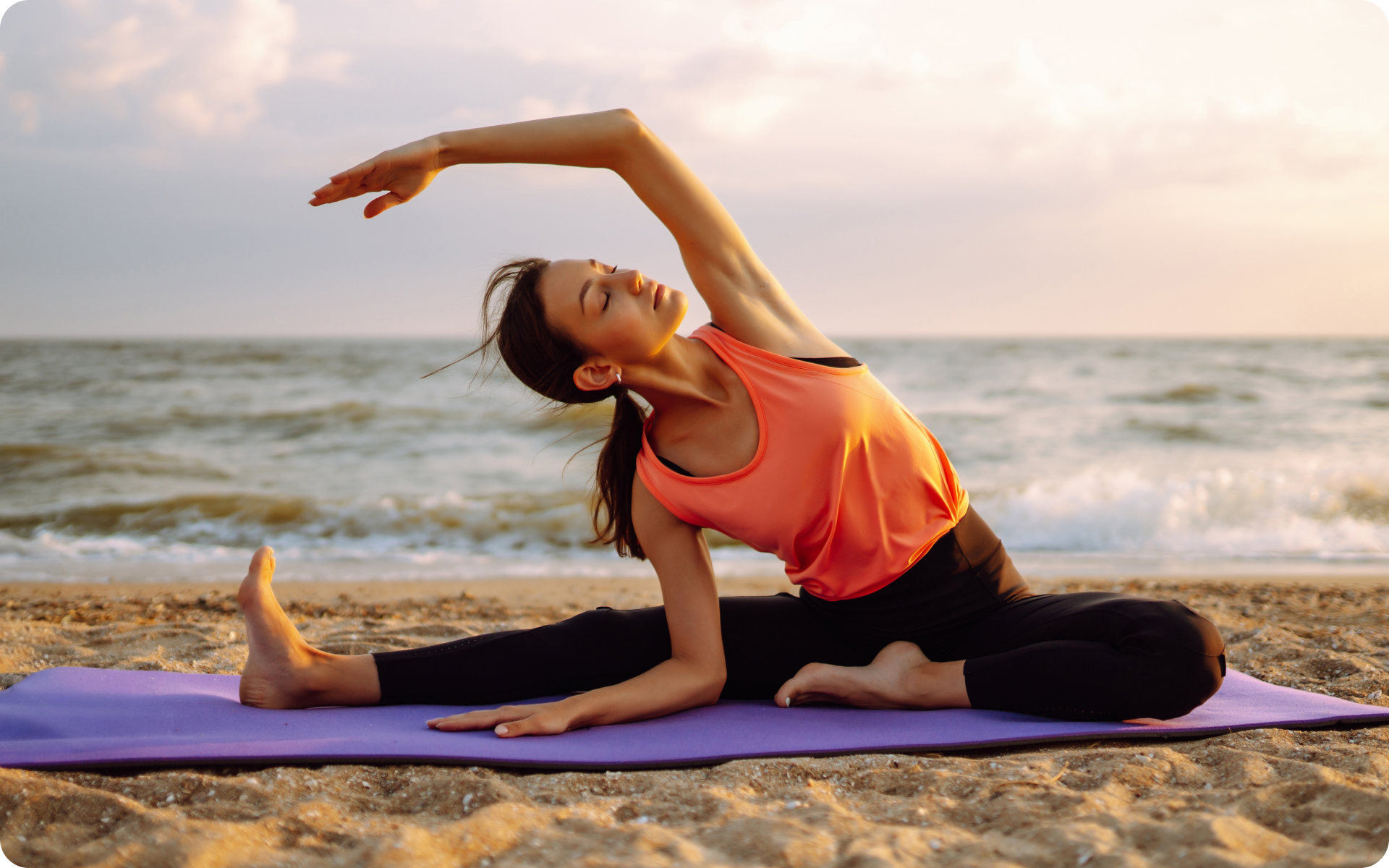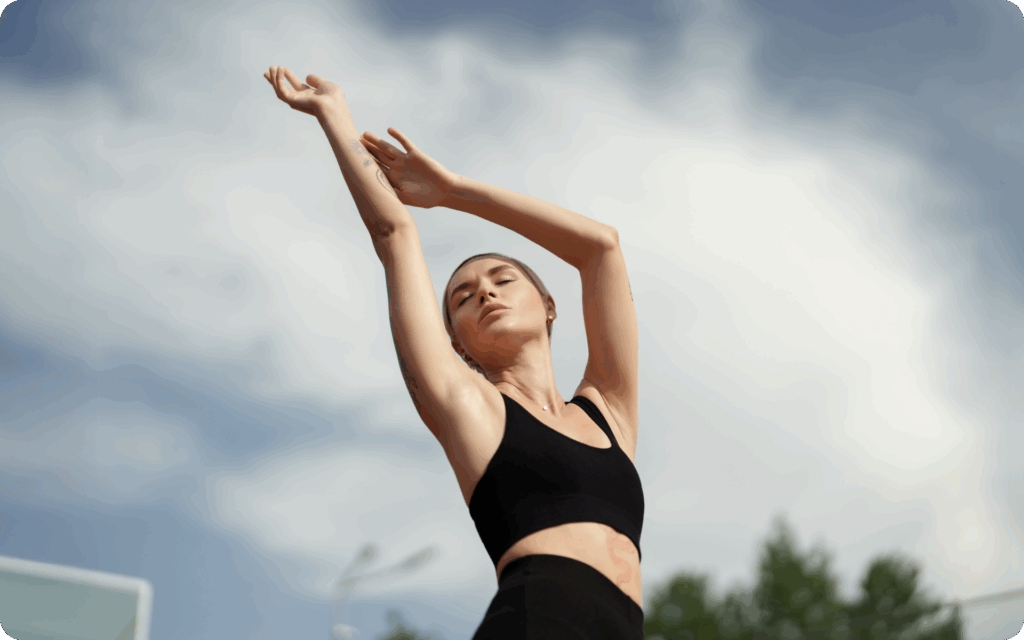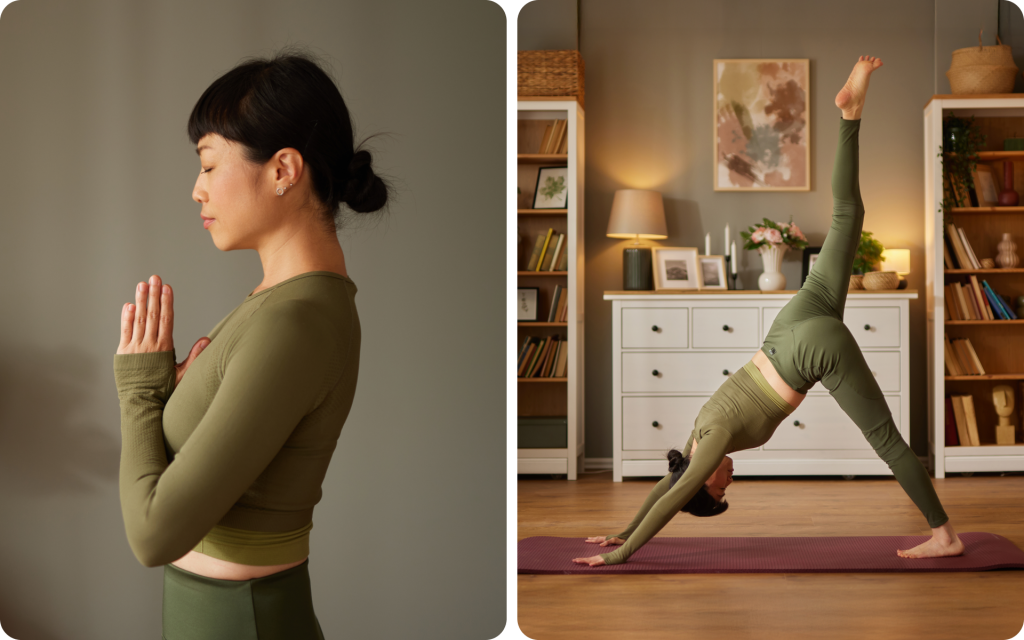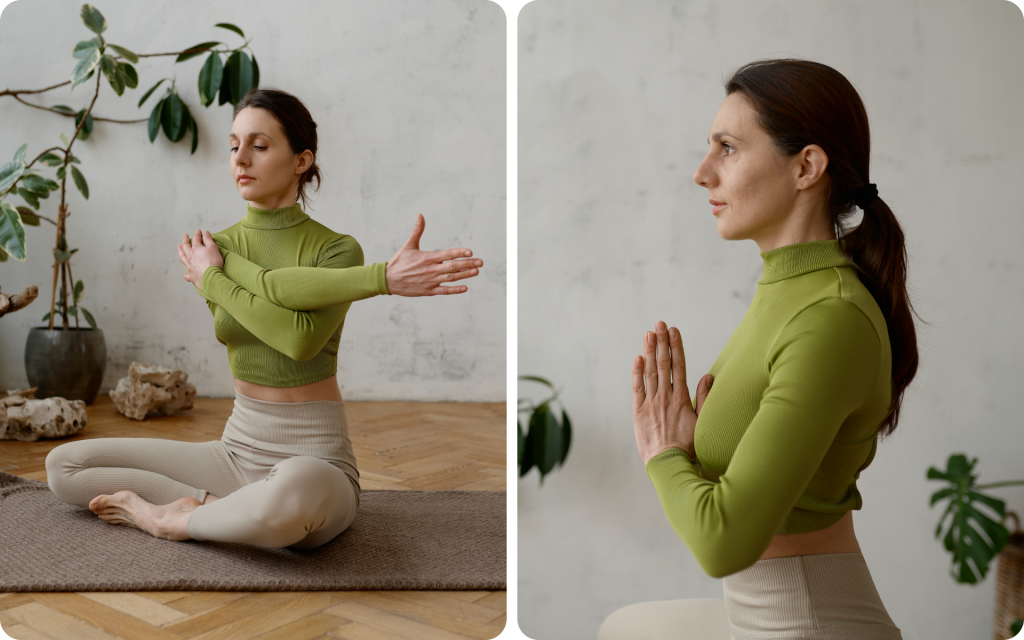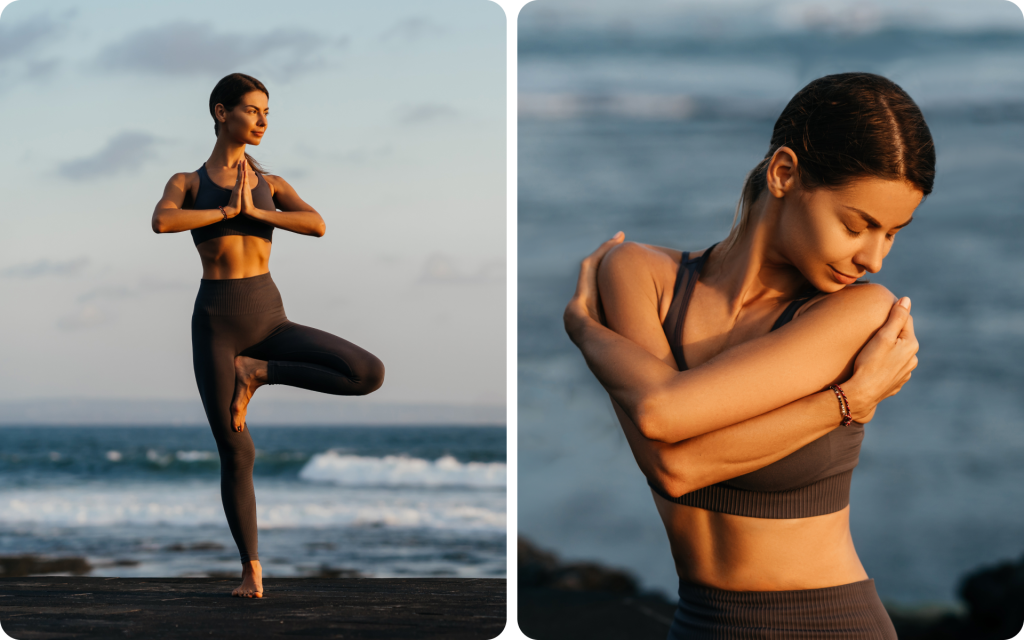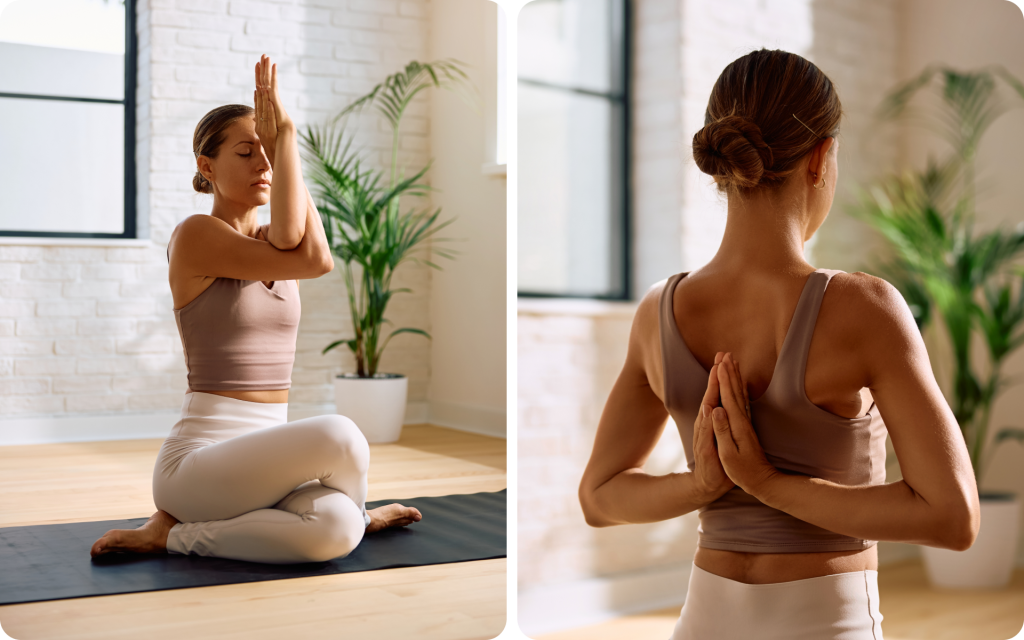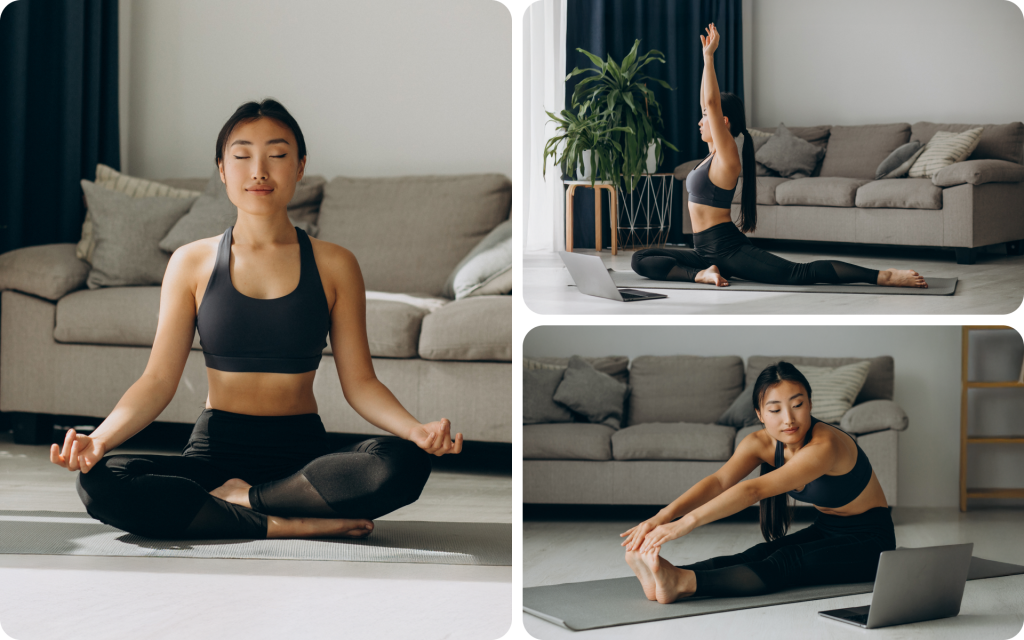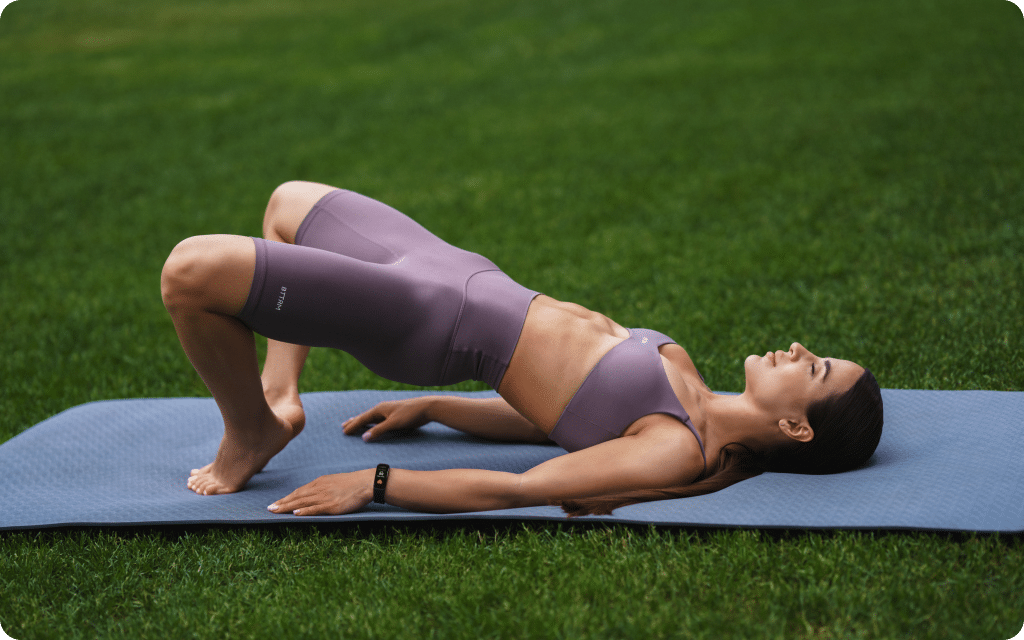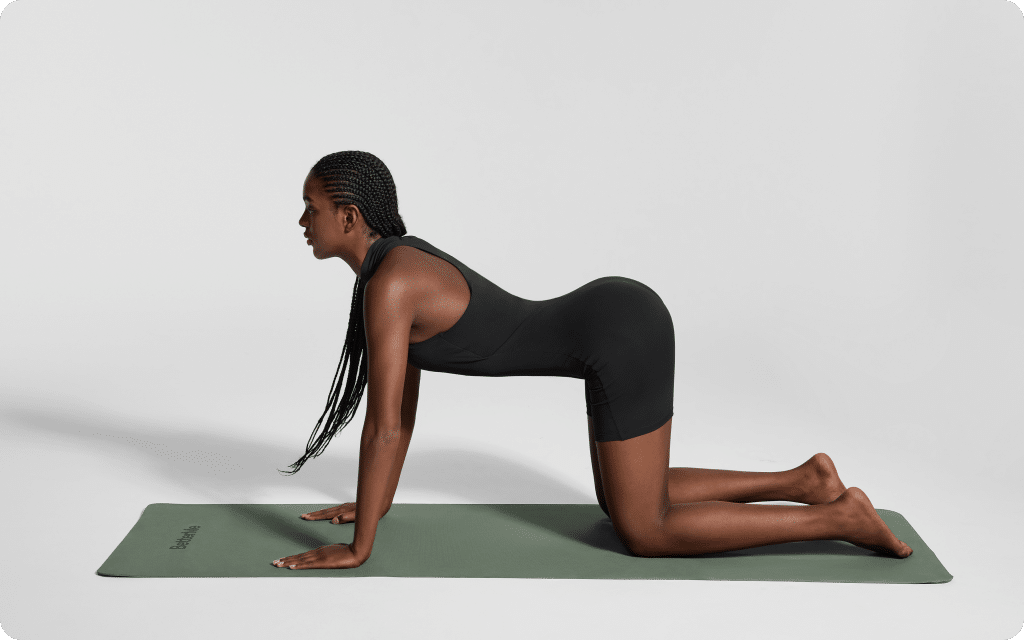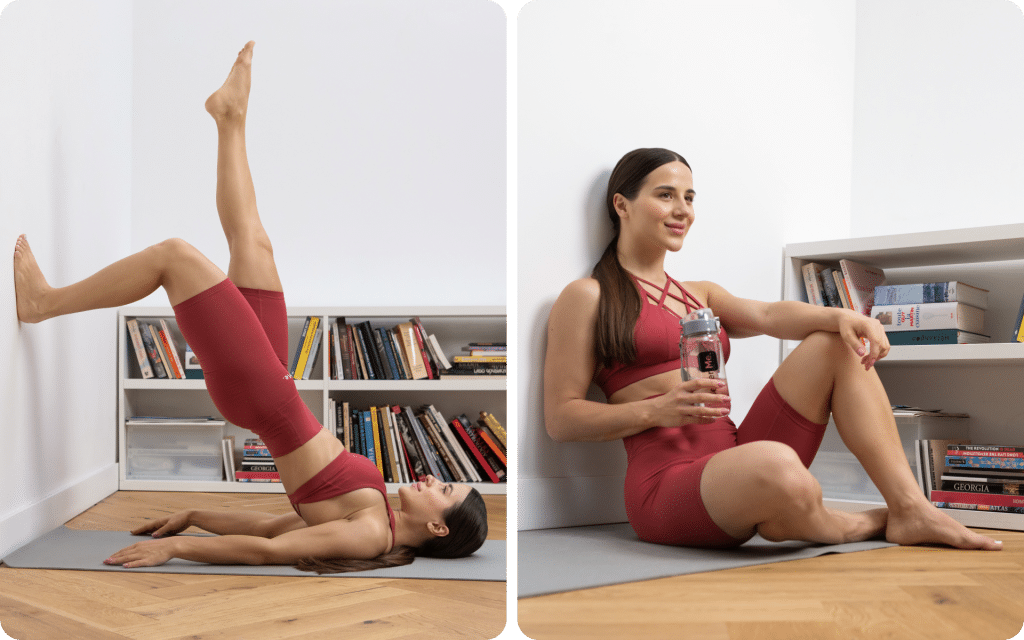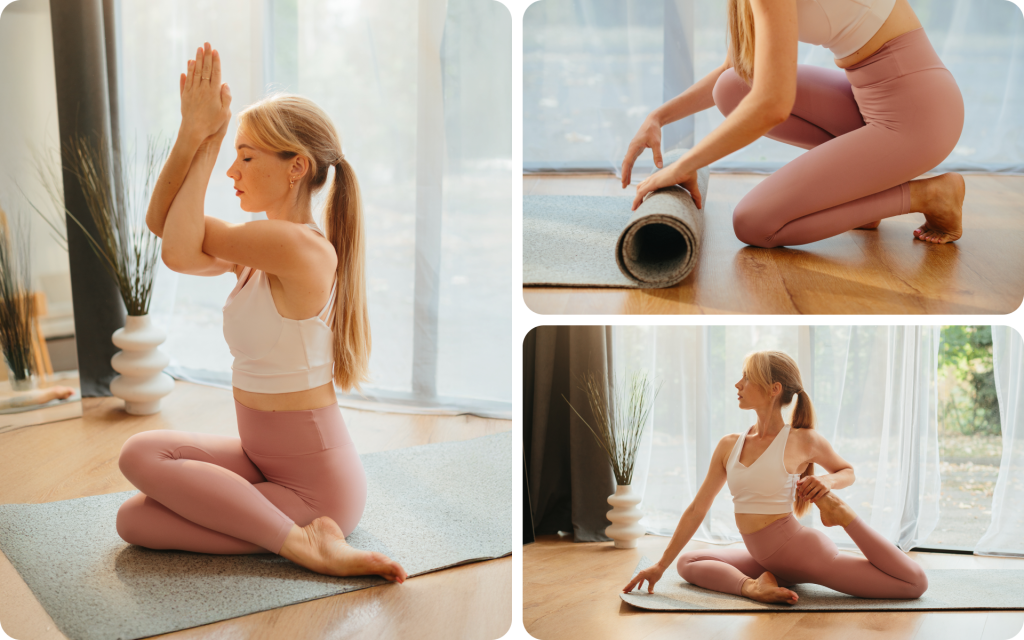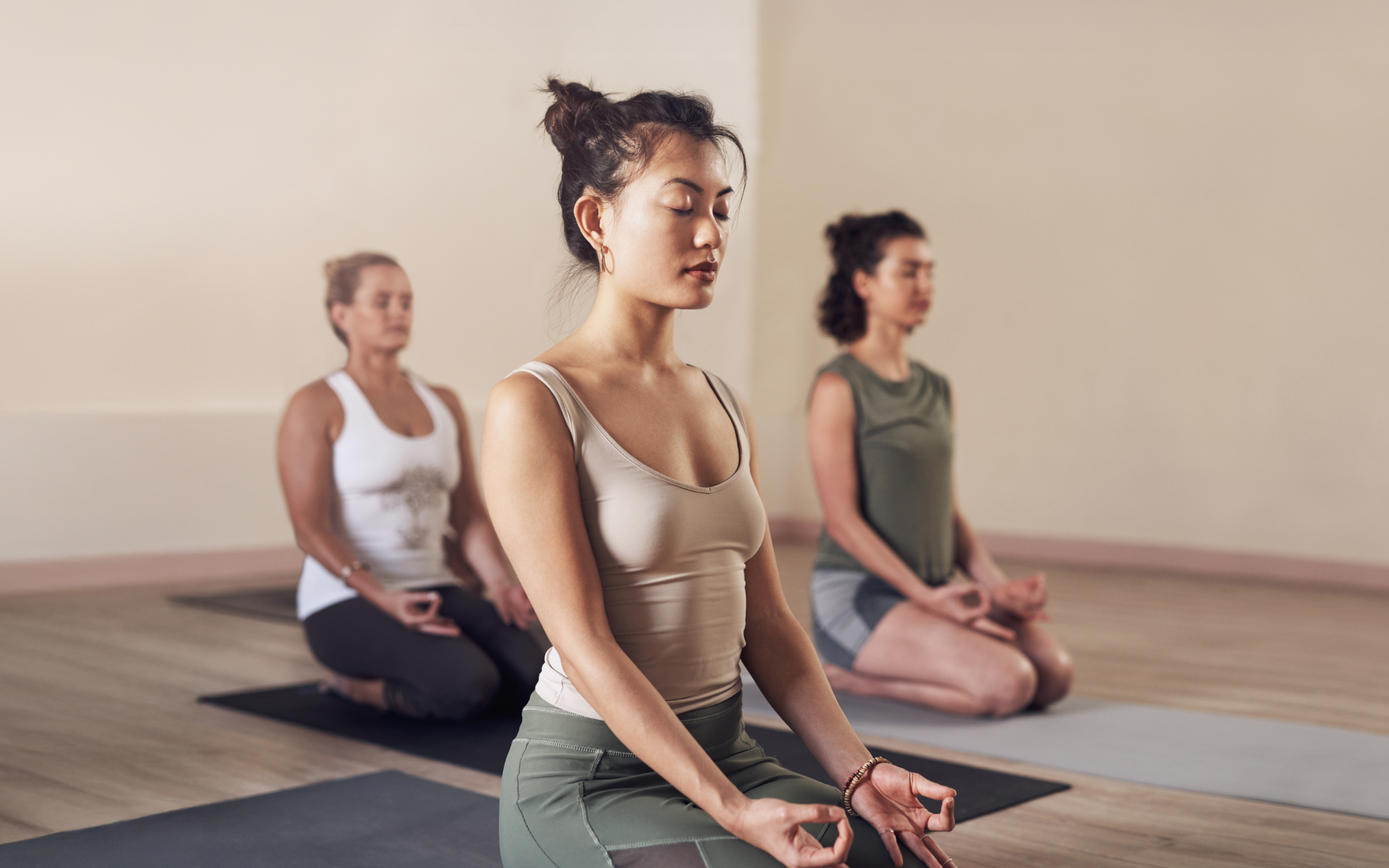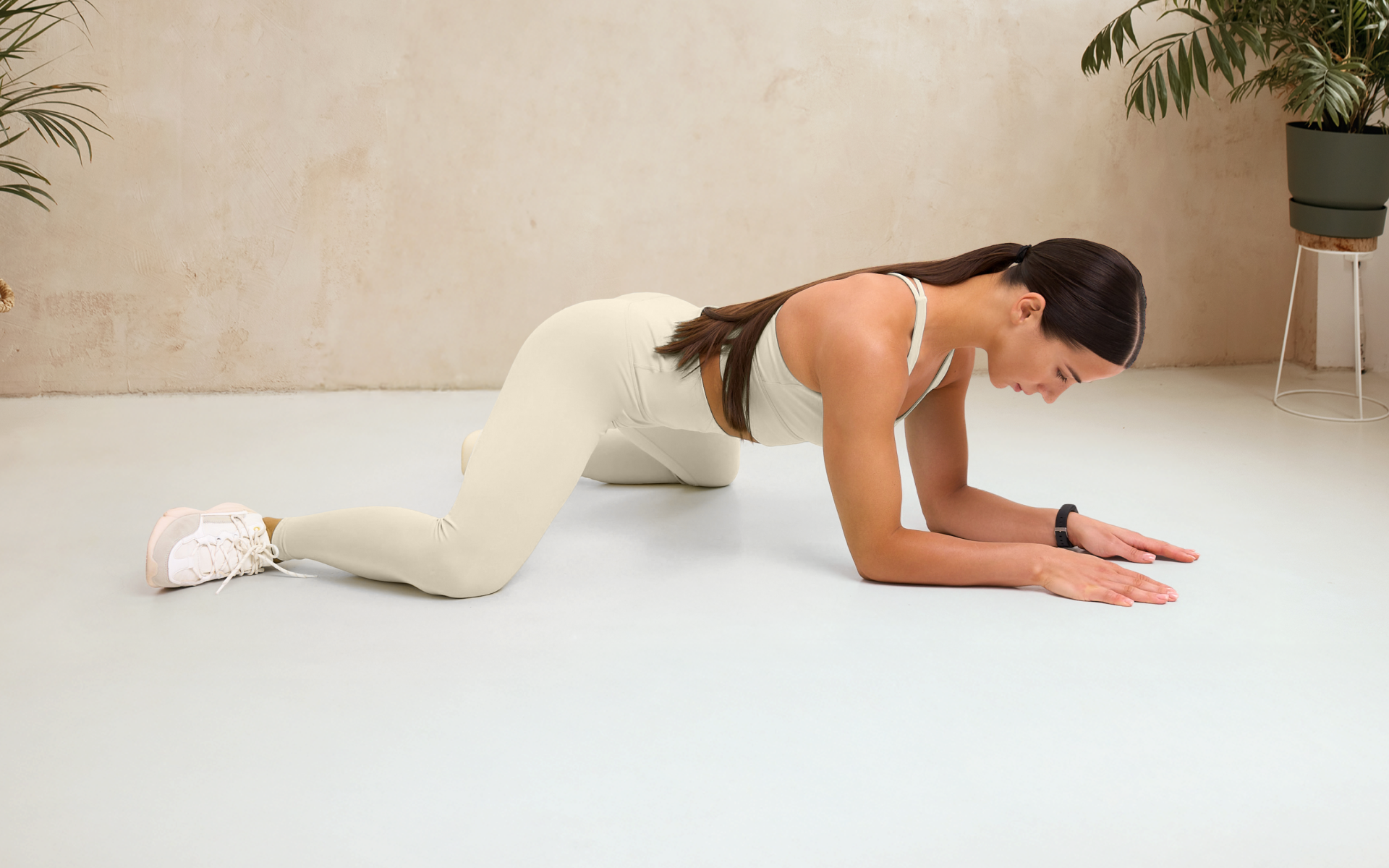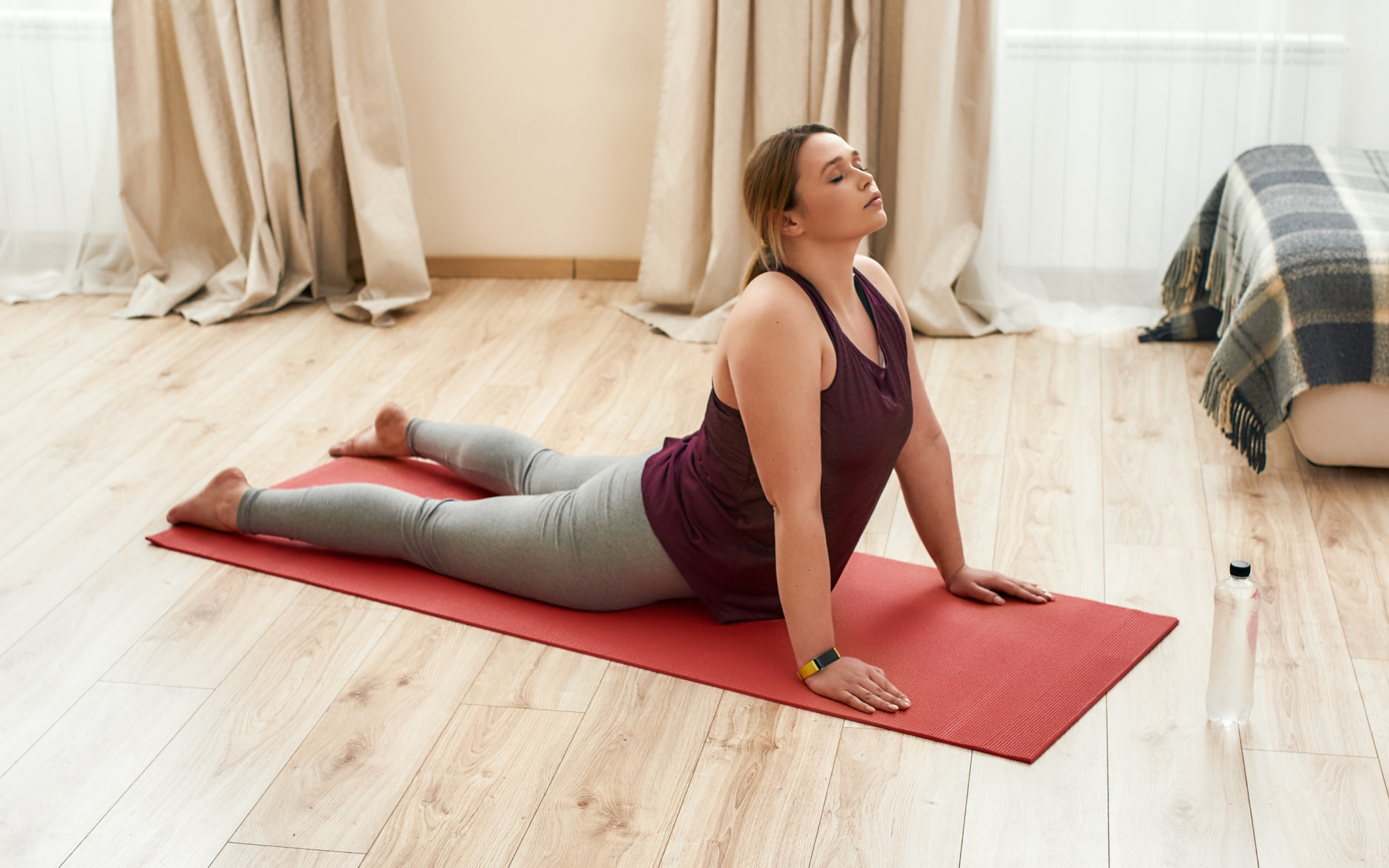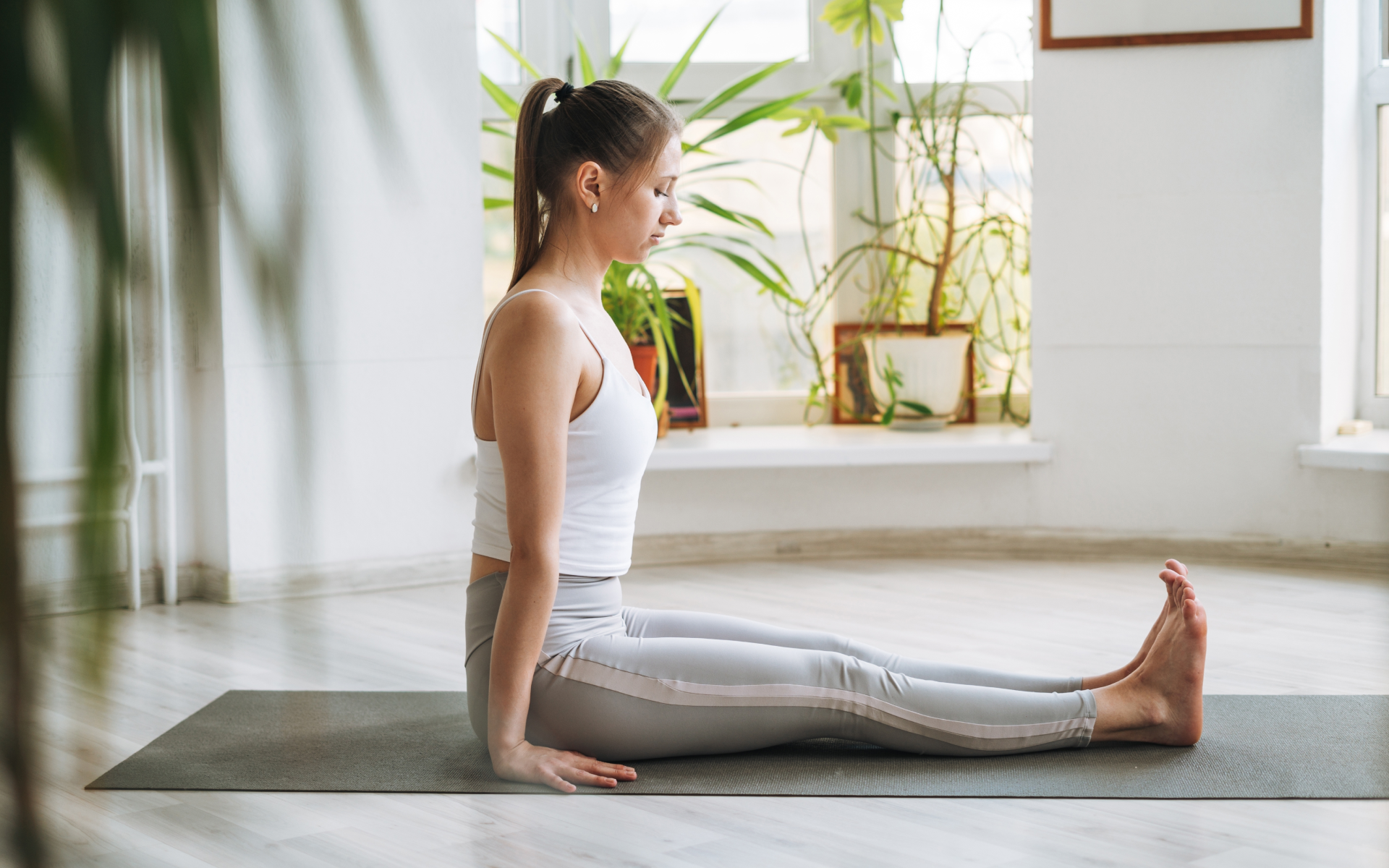Do you ever feel like your body is moving, but your mind is somewhere else? It’s easy to go through the day on autopilot, feeling disconnected from how you really feel.
Somatic yoga moves are designed to help rebuild the connection between your mind and body through slow, mindful movement and increased body awareness (1). Whether you’re new to somatic practices, an older adult who is looking for a gentler form of movement, or simply want to reconnect with your body, somatic yoga can be an effective solution. And as long as you don’t have any medical restrictions, you can start practicing right away.
In this article, you’ll learn what somatic yoga is, who can benefit from it, simple moves to get started with, and how to begin practicing at home.
What Is a Good Way to Practice Somatic Yoga Moves?
Somatic yoga moves use traditional yoga postures, which are known as asanas, but shift the focus to internal awareness (1, 2). The goal is to tune in to subtle sensations as you move (such as tension, warmth, or tightness) and respond in ways that gently support release and restore balance to your mind and body (3).
While many yoga poses can be adapted for a somatic practice to support a wide range of benefits, the goal remains the same: to notice and explore these internal signals with curiosity, patience, and self-compassion (2). So, the best way to start is to simply pick a somatic yoga routine or tutorial and explore the movements at your own pace.
That being said, somatic yoga shouldn’t replace professional medical care. If you’re dealing with any medical or mental health challenges, consult your healthcare provider before you start any new wellness practice to make sure it’s right for your needs and goals.
Read more: What are Restorative Somatic Relaxation Techniques?
What Is Somatic Yoga Movement?
Somatic yoga uses familiar yoga postures, but it shifts the focus away from physical performance to your internal experience (1). Simply put, it’s less about how the pose looks and more about what you sense while doing it.
In fact, the word somatic comes from the Greek word soma, meaning “the living body” (4). In this context, it refers to the first-person experience of how your body feels from within, not how it appears from the outside.
Another key part of somatic movement is building greater body awareness, particularly in these three areas (5):
- Interoception: Sensing internal signals such as breath, heart rate, or tension
- Exteroception: Noticing external cues such as temperature, touch, sound, or other environmental stimuli
- Proprioception: Knowing your body’s movement and position in space
Reasons why BetterMe is a safe bet: a wide range of calorie-blasting workouts, finger-licking recipes, 24/7 support, challenges that’ll keep you on your best game, and that just scratches the surface! Start using our app and watch the magic happen.
What Is an Example of a Somatic Movement?
Almost any movement can become somatic, as long as you shift your focus away from performance and tune in to how it feels inside (6). By simply slowing down and paying attention, you can bring somatic awareness to many everyday movements.
For example, a seated twist can become a somatic practice when you focus on how your spine feels as it moves, how your breath changes, and any subtle sensations that arise (7). The goal isn’t to twist as far as possible, but to listen to your body and respond with care and intention.
Other common somatic movements include gentle yoga poses, stretching, walking, and much more. If you’re ready to dive deeper, the BetterMe app offers guidance and plenty of somatic resources to support your journey.
How Is Somatic Yoga Different from Regular Yoga?
At first glance, somatic yoga may look like regular yoga, but the intention behind it is quite different. Traditional yoga can sometimes become goal-oriented, encompassing a variety of focuses such as flexibility, balance, and other physical milestones (8).
Somatic yoga, on the other hand, is about slowing down, tuning in, and letting your body guide the experience (1). You might still do familiar poses, but the focus shifts inward to how each movement feels and the sensations that arise within your body.
It’s worth noting that yoga was originally created as a mind-body practice, so it naturally lends itself to a somatic approach (8). However, to truly practice somatic yoga, it’s important to let go of external goals and focus more on your inner experience.
Who Can Benefit from Somatic Yoga?
If you’re wondering, “Can beginners do somatic yoga?” The answer is yes. Somatic yoga is designed to meet you where you are, regardless of your age, mobility, fitness level, or experience with yoga. Below are some groups who could potentially benefit from adding somatic yoga moves into their routine.
Somatic Yoga Moves for Beginners
Somatic yoga is gentle, intuitive, and low-impact, which makes it a great option for beginners or anyone who is easing back into movement after a break (1, 2). As the focus is on internal awareness rather than perfect form, there’s no pressure to get every pose “right”.
Somatic yoga exercises for beginners often involve simple, low-effort movements and stretches that don’t require too much flexibility or strength. Movements such as shoulder rolls, seated yoga flows, and child’s pose can all be gentle yet effective starting points.
Tip: Start slow and stick with simple poses first. Once you feel comfortable, let your body guide the pace as you gradually build comfort and confidence.
Somatic Yoga Moves for Seniors
Somatic yoga may also be beneficial for older adults, as it builds body awareness while prioritizing comfort and safety (2, 9). Movements are typically slow and can be adapted for people of any age group, including those with limited mobility or balance concerns.
Chair yoga moves for seniors are particularly helpful, offering the benefits of somatic movement without putting strain on the joints or muscles (10, 11). Common poses such as cat-cow or spinal twists can be easily modified using a chair, allowing you to move mindfully while reducing the risk of falls or injury.
Tip: If you’re not using a chair, consider placing a cushion, folded blanket, or yoga mat under you for extra support and stability during your practice.
Whether you’re a workout beast or just a beginner making your first foray into the world of fitness and dieting – BetterMe has a lot to offer to both newbies and experts! Install the app and experience the versatility first-hand!
Somatic Yoga Moves for Trauma
Somatic yoga poses for trauma offer a way to release emotions that manifest physically in symptoms such as sleep disturbance or chronic muscle tension and reconnect with your body, particularly when words alone aren’t enough to bring relief (12). It’s meant to be done in a safe environment, gradually using movement to explore and process past experiences without pressure or overwhelm.
If you’re working through trauma, it’s essential that you work with a licensed mental health professional or somatic therapist. They can provide the necessary guidance and support to help you move through the healing process safely and at your own pace.
Tip: If you’re looking for a somatic therapist who specializes in trauma, visit Psychology Today’s search tool to find providers in your area (United States only).
Somatic Yoga Moves for Weight Loss
While somatic yoga isn’t designed for weight loss, it can support healthier lifestyle habits that contribute to better weight management over time (13, 14). Somatic practices can also help reduce stress, which is often an overlooked factor in losing weight (15).
If your main goal is weight loss, the best approach is to combine regular physical activity with balanced nutrition (16). As this is often easier said than done, working with a nutritionist or dietitian is beneficial to help you build a plan that suits your needs.
Tip: If you want to incorporate somatic yoga moves in your weight loss routine, you should aim for more dynamic flows that raise your activity level in a gentle, sustainable way.
How to Start Somatic Yoga at Home
Starting somatic yoga at home can be a simple and rewarding way to reconnect with your body. With just a few intentional adjustments to your space and mindset, you may find it easier to start exploring the practice and its potential benefits on your own.
Tips for Home Practice
Creating a calm, supportive environment can make a big difference in your somatic yoga experience. When your space feels safe and distraction-free, it’s easier to tune in and focus on your internal sensations without outside noise pulling your attention away.
Here are some helpful tips to consider when practicing somatic yoga at home:
- Set up your space: Choose a quiet area where you feel safe, relaxed, and comfortable to engage in somatic movement exercises without distractions.
- Wear comfortable clothing: Opt for loose, breathable clothing that doesn’t restrict your movement, allowing you to move freely and feel most at ease.
- Focus on your breath: Breathe deeply, inhaling through your nose and exhaling through your mouth, to help you stay grounded and present in each movement.
- Use supportive props: Consider using blankets, cushions, yoga blocks, mats, or a chair to help you feel safe and supported during your practice.
- Minimize any distractions: Silence your phone, let others know you need uninterrupted time, or remove anything else that may pull your focus away.
- Let go of performance goals: Remember, there’s no need to “master” any of the poses – just stay curious and listen to what your body is telling you.
How Do I Know I’m Doing Somatic Yoga Moves Correctly?
Unlike traditional workouts, there’s no single “right” way to do somatic yoga. It’s normal to feel unsure at first, particularly if you’re used to intense or fast-paced movement. Over time, though, tuning into your body can feel more natural, intuitive, and even comforting.
It’s also important to note that the effects of somatic yoga can vary widely from person to person. Everyone’s journey looks different, and that’s completely normal. The key is to listen to your body, move at your own pace, and find what works best for you.
Here are some signs that you’re on the right track (6):
- Your movements feel intentional and natural, not rushed or forced.
- You’re listening to your body’s cues and not pushing past discomfort.
- You’re focusing on internal awareness (e.g. breath, tension) over perfect form.
- You’re syncing your breath with each movement to stay grounded and present.
- You feel calmer or more balanced afterward, even if the changes are subtle.
- You may take a moment to reflect after your practice, either by journaling or simply noticing how your mind and body feel.
Read more: The Power of Somatic Exercises for Promoting Calmness: A Comprehensive Guide
What Are Some Somatic Yoga Moves for Beginners?
If you’re a beginner or looking to ease into somatic yoga, these beginner-friendly moves can be a great starting point. Each pose is designed to build mind-body awareness and help you better tune in to your body, without the need for any previous flexibility or experience.
Supine Pelvic Tilts
Supine pelvic tilts help build awareness in your lower back, hips, and core, which makes them ideal for anyone who is dealing with lower-back discomfort or stiffness (17). This can be a great place to begin, and as you become more comfortable, you can try adding variations such as adding a march or knee tucks to the pelvic tilt (17).
To get started, here’s how to do a basic somatic supine pelvic tilt exercise (18):
- Lie on your back with your knees bent and your feet flat on the floor, hip-width apart.
- Rest your arms at your sides comfortably with your palms facing down.
- Take a slow, deep breath in through your nose, allowing your chest and abdomen to gently expand as you prepare for movement.
- As you exhale slowly, gently engage your core muscles and press your lower back into the floor by tilting your pelvis slightly upward.
- Hold this position for up to 10 seconds while breathing naturally, feeling the sensations in your lower back and hips without judgment.
- Continue breathing as you slowly release and return to the starting position.
- Repeat this for several repetitions, paying attention to any sensations that arise and moving at your own pace.
Somatic Cat-Cow
The somatic version of the traditional cat-cow pose encourages slow, more intentional movement in sync with your breath (2). It’s meant to be a calming exercise that’s ideal for beginners or anyone who is experiencing tension in the back or neck area.
Here’s how to do a somatic cat-cow exercise on your own (19):
- Start on your hands and knees in a tabletop position, aligning your shoulders over your wrists and hips over your knees.
- Inhale slowly as you arch your spine, drop your belly, and lift your chest and tailbone toward the ceiling (cow pose).
- Exhale slowly as you round your spine, tucking your chin and tailbone inward toward the floor (cat pose).
- Move slowly between these poses, syncing your breath with each transition.
- Repeat this process for as long as comfortable, paying close attention to how your body feels throughout each motion.
Seated Shoulder Rolls
Seated shoulder rolls are another valuable option for beginners, older adults, office workers, or anyone who is holding tension in their upper body (20). They can also work well as a warm-up or cool-down to ease areas of tightness and support mindful movement.
Here’s how to do seated shoulder rolls with somatic awareness (21):
- Sit upright in a chair with your feet flat on the floor and your hands resting on your thighs or at your sides (whichever is more comfortable).
- Keep your back straight, your shoulders relaxed, and your chin slightly tucked.
- When you’re ready, take a slow and deep breath in through your nose.
- As you exhale, roll your shoulders up toward your ears, then back, down, and forward in one smooth, circular motion.
- Breathe in again and repeat this circular motion 2 to 4 times, moving slowly and noticing how your shoulders and upper back feel.
- After a few rounds, reverse the direction: Inhale gently, then as you exhale, roll your shoulders down, then back, up, and forward.
- Continue for 2 to 4 rounds in this direction, breathing deeply and focusing on any tension you feel with each rotation.
Legs-up-the-Wall
The legs-up-the-wall pose, which is also known as Viparita Karani, is a restorative yoga posture that helps calm the nervous system and relieve feelings of stress or tension (22). It can be particularly helpful for winding down at the end of the day, and it’s suitable for nearly all ages and fitness levels.
Here’s how to do the legs-up-the-wall pose somatically (22):
- Sit sideways next to a wall, with one hip close to the base and your knees bent.
- Gently lie back as you swing your legs up the wall, adjusting so your hips are a few inches from the wall (or wherever feels most comfortable).
- Rest your arms at your sides, palms facing up, and allow your eyes to close naturally.
- Breathe slowly and deeply, relaxing and settling into this position.
- Stay here for around 5 to 10 minutes, or as long as it feels comfortable, paying close attention to how your body feels with each inhale and exhale.
- To come out, bend your knees and roll to one side, pausing for a breath before sitting up all the way.
Seated Spinal Twist
Seated spinal twists are another beginner-friendly exercise that supports mobility and body awareness while remaining gentle and accessible (23). They can be done either on the floor or in a chair, which makes them particularly well-suited for older adults or anyone who needs a more stable, supported way to move.
Here’s how to do a somatic seated spinal twist in a chair (23):
- Sit in a sturdy chair with your feet flat on the floor and your knees hip-width apart.
- Relax your shoulders and take a few deep breaths to settle in.
- Inhale deeply and lengthen your spine, extending toward the ceiling, as if creating a space between each vertebra.
- Exhale slowly as you twist your torso to the right, placing your right hand on the back of the chair for support.
- Place your left hand on the outside of your right thigh and gently deepen the twist with each exhale, keeping your shoulders relaxed.
- Turn your head to look softly over your right shoulder, and hold this position for several slow, deep breaths.
- Inhale slowly to unwind and return your torso to the center position.
- Repeat the twist on the left side, allowing your body to guide the pace and move naturally with each inhale and exhale.
It depends. Pilates is an exercise system that incorporates elements of body awareness and slow, intentional movement, which overlaps with somatic principles (24). It can be considered somatic movement when it’s practiced with a sole focus on internal awareness, but not when it’s used to achieve any fitness or appearance-based goals. Somatic yoga may use traditional yoga poses, but it shifts the focus from external form and performance to internal awareness and mindful movement (1, 8). It encourages you to tune into subtle sensations in the body, breathe deeply, and reconnect with your body rather than achieving specific poses as seen in traditional yoga styles. Somatic yoga isn’t primarily designed for weight loss, but research has found that traditional yoga can help relieve stress and promote mindfulness, which may indirectly help with weight management (13, 14). For weight loss specifically, it’s best to combine regular physical activity with a balanced diet or speak with a nutritionist to get a personalized weight loss plan (16). The difficulty of yoga styles will ultimately depend on your experience, physical ability, and comfort level. Generally, styles such as hot yoga or power yoga are considered most challenging due to their intensity, fast pace, and physical demands (25).Frequently Asked Questions
Is Pilates a somatic movement?
How is somatic yoga different from regular yoga?
Can you lose weight with somatic yoga?
What is the hardest yoga to learn?
The Bottom Line
Somatic yoga moves can be a mindful, gentle way to reconnect with your body, regardless of your age, experience, or fitness level. Whether you’re managing stress, releasing tension, or simply looking to deepen your body awareness, somatic yoga moves can be a powerful addition to your wellness routine.
Download the BetterMe app for more guidance, tools, and resources to support your mental and physical well-being.
DISCLAIMER:
This article is intended for general informational purposes only and does not serve to address individual circumstances. It is not a substitute for professional advice or help and should not be relied on for making any kind of decision-making. Any action taken as a direct or indirect result of the information in this article is entirely at your own risk and is your sole responsibility.
BetterMe, its content staff, and its medical advisors accept no responsibility for inaccuracies, errors, misstatements, inconsistencies, or omissions and specifically disclaim any liability, loss or risk, personal, professional or otherwise, which may be incurred as a consequence, directly or indirectly, of the use and/or application of any content.
You should always seek the advice of your physician or other qualified health provider with any questions you may have regarding a medical condition or your specific situation. Never disregard professional medical advice or delay seeking it because of BetterMe content. If you suspect or think you may have a medical emergency, call your doctor.
SOURCES:
- Somatic Practice in Yoga Therapy: Explorations of body, movement, mind, and self (2024, books.google.com)
- Impact of Somatic Yoga and Meditation on Fall Risk, Function, and Quality of Life for Chemotherapy-Induced Peripheral Neuropathy Syndrome in Cancer Survivors (2019, journals.sagepub.com)
- Finding Our Way Back into the Body Through Somatic Movement: A Journey Through the Meanings and Challenges of Mindfulness (2024, digitalcommons.lesley.edu)
- What’s in a Name? Somatics and the Historical Revisionism of Thomas Hanna (2022, cambridge.org)
- An Overview of the Bodily Awareness Representation and Interoception: Insights and Progress in the Field of Neurorehabilitation Research (2024, nih.gov)
- What is Somatic Movement? (2016, somaticmovementcenter.com)
- Seated Twist (2020, somaticmovementcenter.com)
- Physiological and psychological responses to different yoga styles (2018, journals.lww.com)
- Somatic movement intervention among older adults to improve body awareness and spine mobility: A pilot study (2025, bodyworkmovementtherapies.com)
- Take a Seat for Yoga with Seniors: A Scoping Review (2022, lidsen.com)
- Effect of Chair Yoga Therapy on Functional Fitness and Daily Life Activities among Older Female Adults with Knee Osteoarthritis in Taiwan: A Quasi-Experimental Study (2023, nih.gov)
- Trauma Sensitive Yoga as a complementary treatment for posttraumatic stress disorder: A Qualitative Descriptive analysis (2018, nih.gov)
- Mind−Body Practice and Body Weight Status in a Large Population-Based Sample of Adults (2016, sciencedirect.com)
- A preliminary investigation of yoga as an intervention approach for improving long-term weight loss: A randomized trial (2022, nih.gov)
- The Role of Stress and Mental Health in Obesity (2025, mdpi.com)
- Physical Activity and Weight Loss Maintenance (2025, nih.gov)
- Pelvic Tilt (n.d., physio-pedia.com)
- Pelvic tilt exercise (n.d., mayoclinic.org)
- Cat/cow pose (2023, mayoclinic.org)
- 11 Stretches to Help Relieve Tight Shoulders (2023, healthline.com)
- Shoulder roll (seated) (2024, northshore.org)
- Legs Up the Wall Pose (2025, yogajournal.com)
- Chair Seated Twists (n.d., tummee.com)
- Pilates (2006, sciencedirect.com)
- Effects of Temperature and Tempo: Evaluating How Much Time in a Typical Community-Based Yoga Class Is Moderate-Intensity Aerobic Activity (2023, researchgate.net)
